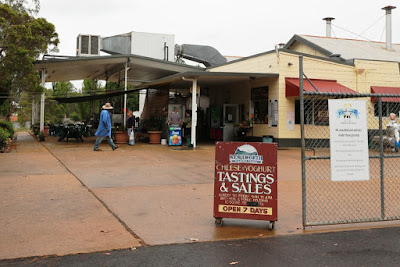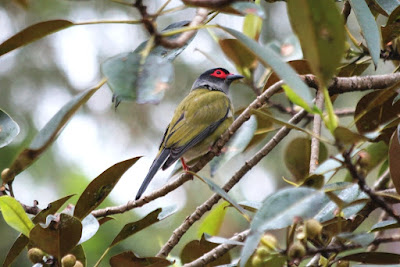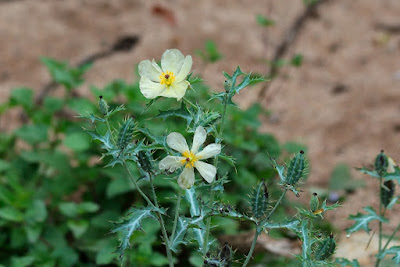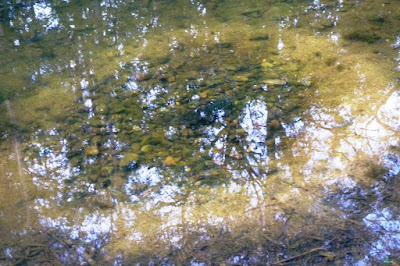We decided to do a quick camping trip to Charlie Moreland Campground to check out the redevelopment of the site and test a few mod cons we've installed in the van. The campground is about 2 hours drive north of the Brisbane CBD. If you are towing or driving a large rig avoid the Obi Obi Road. We went further north and took the Eumundi-Kenilworth Road instead.
On the way we dropped into the charming village of Kenilworth. The Kenilworth Cheese Factory has a store with a sample station to help you make your choices from their large range of cheeses. They also make yogurt and mousse and sell sauces, jams and condiments.
 |
| Kenilworth Cheese Factory |
There is a really nice park with toilets, picnic tables, BBQ's and an excellent children's playground with a flying fox, opposite the factory.
The Kenilworth Showground is very popular with RV's and costs $16 per night for two people with power and water. There are several cafes in the main street as well as a grocery store and bakery.
The turnoff for Charlie Moreland Campground is about 7 km south of Kenilworth. Just past the turnoff (going south) is Little Yabba Creek Park, a free 24 hour rest area. Fig Tree Walk is opposite the rest area and is worth a visit. The walk is a 780 m, Grade 1 circuit. We did not call in this time as it was raining and we have done the walk a couple of times previously.
Charlie Moreland Campground is on Sunday Creek Road about 5 km from the turnoff. The road is unsealed but wide except for a one-way bridge and a concrete causeway just before the campground. As this is a Queensland National Park managed campground it is necessary to book online before arriving. There is no phone or internet reception at the campground but there is a pay phone at the Ranger Station on the way in. Standard NPRSR fees apply of $5.95 per adult, children under 5 yrs are free and there is a family fee of $23.80 for 1-2 adults and 6-7 children (up to 8 people in total).
 |
| Concrete causeway just before the entrance to Charlie Moreland Campground. |
The camping area is grass and dirt with no designated sites and is available for tents, vans, camper trailers and motor homes. The campground has been redeveloped in recent times and now contains four amenities buildings with flushing toilets.There are non-potable water taps and fire rings (BYO wood) scattered throughout the campground. Dogs and generators are not permitted. There are no showers or bins provided. A large enclosed horse paddock is at the back of the campground. There is a new Day Use Area with picnic tables, BBQ's and access to an amenities block.
 |
| Charlie Moreland Campground. |
 |
| The newly developed Charlie Moreland Day Use Area |
In the middle of the campground a large fig tree was in fruit which attracted quite a few birds.
 |
| Australian Figbird, male. |
 |
| Wompoo Fruit-Dove |
 |
| Topknot Pigeon |
On the first afternoon we walked the Piccabeen Circuit (3.5 km, Class 3) and combined it with the Little Yabba Creek Circuit (1.5 km, Class 3).
Native Hibiscus and Blackbean trees were in flower on the banks of Little Yabba Creek. There are also quite bad infestations of Castor Oil Plant, Scotch Thistle and Mexican Prickly Poppy (Goat Weed).
 |
| Native Hibiscus Hibiscus heterophyllus |
 |
| Black Bean Tree flowers Castanospermum australe |
 |
| Mexican Prickly Poppy Argemone mexicana |
 |
| Spangled Drongo and Lewin's Honeyeater. |
At the first crossing of the creek, giant rocks had been dislodged by rushing water but it was still possible to cross over carefully without getting your feet wet.
We saw a large variety of birds on the Little Yabba Creek section of the walk but not many on the Piccabeen Circuit. We could hear Paradise Rifflebirds and Catbirds calling but we didn't see them. Due to the overcast and wet conditions the light was poor and our bird photos didn't come out very well once we crossed the creek. See bird list for the trip below. We were excited to see Noisy Pittas three times but they weren't hanging around to have their photos taken and we only got 2 very blurry photos.
Little Yabba Creek is worth a closer look. We saw several types of small fish including Pacific Blue-eye P.signifer, a small eel and lots of water beetles. We heard the plop of a turtle returning to the water from a log.
 |
| Water Boatman and Water Beetles |
We saw several circles in the creek which are spawning nests created by native Eel-tailed catfish (Thanks to the excellent facebook group Australian Marsupials, Reptiles, Amphibians, Invertebrates and Plants for making sure I got my facts straight).
 |
| Abandoned Eel-tailed catfish Tandanus tandanus spawning nest. 11/2015 |
We took this photo of Little Yabba Creek in October 2011. The fish is inside the ring.
 |
| Eel-tailed catfish in spawning ring 10/2011 |
We saw several brightly coloured flies which I think are Bristle Fly zosterops (but I'm happy to stand corrected if there are any fly experts reading this). I love the patches of a small green plant along the edges of the track.
There were a few rain showers about and unfortunately, we both managed to get leeches. Next day we were more careful and sprayed the bottoms of our trousers and the tops of our shoes with "Off" which seemed to deter them.
Back at camp a Kookaburra was keeping a close eye on what we were cooking for dinner.
 |
| Perhaps Kookaburras like Kenilworth cheese too. |
We went for a night walk and discovered the campground was alive with very small pademelons but we didn't spot any night birds. We did hear a Southern Boobook calling in the early morning.
We hadn't managed to see any frogs on the walks but in the morning we had a nice surprise when we found a Stony Creek Frog hiding out on the toilet roll in one of the amenities blocks.
 |
| Stony Creek Frog Litoria wilcoxii |
The pademelons were retreating into the bush.
 |
| Red-necked Pademelons |
We took another walk around Little Yabba Creek Circuit. We were hoping to get better photos of the Noisy Pittas but we didn't see any in the morning. We did however see a male Paradise Rifflebird which proved difficult to photograph in the poor light but was very exciting to observe. They are iridescent green and this one gave us good views of its bright yellow mouth.
 |
| Paradise Riflebird, male. |
There is also a shared walk from the campground to the top of Mount Allan (about 9 km, Class 4). The track is open to horses and mountain bikes as well as logging vehicles so care should be taken when walking. We have walked this track in the past and it is a steady uphill slog so fitness is required. The reward is that you can climb the stairs of the 9.6 m fire tower; something that is becoming rarer these days.The 360 degree views from the top are excellent and we have enjoyed a picnic lunch on the top of the tower in the past (we love our picnics).
 |
| Mount Allen Fire Tower 9/2012 |
Birds seen over two days at Charlie Moreland campground: Australian King Parrot, Brown Cuckoo-Dove, Topknot Pigeon, Wompoo Fruit-Dove, Spangled Drongo, Eastern Pale-headed Rosella, Jacky Winter, Lewin's Honeyeater, Paradise Riflebird, Laughing Kookaburra, Sacred Kingfisher, Australian Magpie, Noisy Pitta, Australian Logrunner, Rufous Fantail, White-browed Scrubwren, Brown Gerygone, Brown Thornbill, Bell Miner, Noisy Miner, Eastern Whipbird, Channel-billed Cuckoo, Yellow-tailed Black Cockatoo, Eastern Yellow Robin, Pale-yellow Robin, Golden Whistler, Australasian Figbird, Pheasant Coucal.












